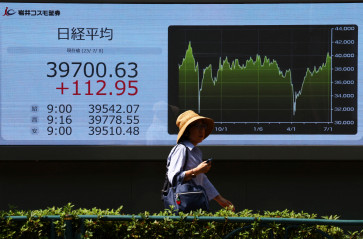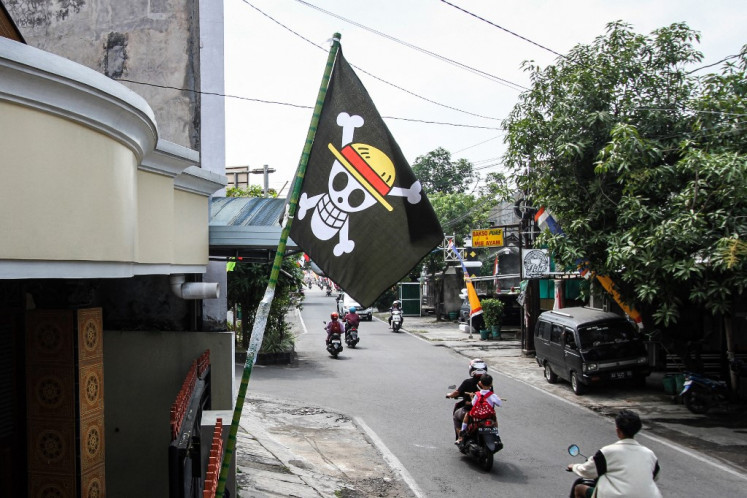Popular Reads
Top Results
Can't find what you're looking for?
View all search resultsPopular Reads
Top Results
Can't find what you're looking for?
View all search resultsInfrastructure development changes map of property business
Built for growth: Workers on the Mass Rapid Transit (MRT) project carry a steel rod at the construction site on Jl
Change text size
Gift Premium Articles
to Anyone
 Built for growth: Workers on the Mass Rapid Transit (MRT) project carry a steel rod at the construction site on Jl. Jendral Sudirman, Central Jakarta recently. Apart from helping to ease the cityâs traffic problems, the MRT will also stimulate property growth in the areas through which the service passes.(JP/P.J. Leo)" border="0" height="367" width="511">Built for growth: Workers on the Mass Rapid Transit (MRT) project carry a steel rod at the construction site on Jl. Jendral Sudirman, Central Jakarta recently. Apart from helping to ease the cityâs traffic problems, the MRT will also stimulate property growth in the areas through which the service passes.(JP/P.J. Leo)
Built for growth: Workers on the Mass Rapid Transit (MRT) project carry a steel rod at the construction site on Jl. Jendral Sudirman, Central Jakarta recently. Apart from helping to ease the cityâs traffic problems, the MRT will also stimulate property growth in the areas through which the service passes.(JP/P.J. Leo)" border="0" height="367" width="511">Built for growth: Workers on the Mass Rapid Transit (MRT) project carry a steel rod at the construction site on Jl. Jendral Sudirman, Central Jakarta recently. Apart from helping to ease the cityâs traffic problems, the MRT will also stimulate property growth in the areas through which the service passes.(JP/P.J. Leo)With more transportation infrastructure and facilities currently being developed, more properties are expected to be built, including vertical residences in the cityâs outskirts.
The acceleration of development of transportation facilities and means, such as toll roads and railways, can significantly change the map of property business.
Currently, serious attention and development are focused on the metropolitan Jadebotabek area that comprises Jakarta, Depok, Bogor, Tangerang and Bekasi.
Based on a 2014 demographic study, with a population of over 30 million, Jabodetbek is the worldâs second-largest metropolitan area after Tokyo-Yokohama.
Around 50 percent of the population is of working age in Bekasi, Depok and South Tangerang. Approximately 2.4 million commuters from these areas travel back and forth to work in Jakarta with 70 percent using their own vehicles and 30 percent using public transportation.
These are some of the basic factors that trigger the development of further public transportation access. While initially toll roads were developed, the governmentâs focus has now spread to railways and commuter lines.
The development of light rapid transit (LRT) will also enable the surrounding areas to grow further and faster, according to Cushman & Wakefield Indonesia research and advisory director Arief Rahardjo.
âThe LRT will have a more expansive reach, passing through many areas, such as Bogor, Cibubur, Bekasi and Cengkareng,â said Arief as quoted by kompas.com.
Simatupang corridor
When it comes to office space development in the capital, the TB Simatupang Business Corridor in South Jakarta indicated a favorable performance during the third quarter of 2015 while the Central Business District (CBD) Jakarta declined.
This was indicated by the 1 percent growth in the office sector to 86 percent. Colliers International Indonesia noted that the office rental cost in this corridor contributed much to the increase in overall rental cost in South Jakarta.
Currently the rental rate is Rp 259,805 (US$18) per square meter per month, which is 6 percent lower than the rate in the previous quarter. However, the decrease is caused more by converting the rates into rupiah from previous calculations in US dollars by the building owners.
Meanwhile, the service charge is now Rp 65,461 per square meter per month, changing little since three months ago.
The TB Simatupang Corridor is also on an upward trend in its strata title for offices, as about 72 percent of the newly available 180,000 square meters have been taken up by the market. This has caused an increase of 4.6 percent in the selling price becoming Rp 33.6 million per square meter, according to property consultant Colliers.
Research conducted by property consultant company Cushman & Wakefield Indonesia indicated similar trends in the office sector of TB Simatupang Corridor. Of the six newly constructed office buildings totaling 229,106 square meters, five are located in this corridor.
span class="caption">Built for growth: Workers on the Mass Rapid Transit (MRT) project carry a steel rod at the construction site on Jl. Jendral Sudirman, Central Jakarta recently. Apart from helping to ease the city's traffic problems, the MRT will also stimulate property growth in the areas through which the service passes.(JP/P.J. Leo) With more transportation infrastructure and facilities currently being developed, more properties are expected to be built, including vertical residences in the city's outskirts. City facility: An overpass connecting Jl. Pangeran Antasari to Blok M in South Jakarta is expected to help solve traffic congestion in the area, which is dense with commercial and residential buildings.(JP/Ricky Yudhistira)
B
The acceleration of development of transportation facilities and means, such as toll roads and railways, can significantly change the map of property business.
Currently, serious attention and development are focused on the metropolitan Jadebotabek area that comprises Jakarta, Depok, Bogor, Tangerang and Bekasi.
Based on a 2014 demographic study, with a population of over 30 million, Jabodetbek is the world's second-largest metropolitan area after Tokyo-Yokohama.
Around 50 percent of the population is of working age in Bekasi, Depok and South Tangerang. Approximately 2.4 million commuters from these areas travel back and forth to work in Jakarta with 70 percent using their own vehicles and 30 percent using public transportation.
These are some of the basic factors that trigger the development of further public transportation access. While initially toll roads were developed, the government's focus has now spread to railways and commuter lines.
The development of light rapid transit (LRT) will also enable the surrounding areas to grow further and faster, according to Cushman & Wakefield Indonesia research and advisory director Arief Rahardjo.
'The LRT will have a more expansive reach, passing through many areas, such as Bogor, Cibubur, Bekasi and Cengkareng,' said Arief as quoted by kompas.com.
Simatupang corridor
When it comes to office space development in the capital, the TB Simatupang Business Corridor in South Jakarta indicated a favorable performance during the third quarter of 2015 while the Central Business District (CBD) Jakarta declined.
This was indicated by the 1 percent growth in the office sector to 86 percent. Colliers International Indonesia noted that the office rental cost in this corridor contributed much to the increase in overall rental cost in South Jakarta.
Currently the rental rate is Rp 259,805 (US$18) per square meter per month, which is 6 percent lower than the rate in the previous quarter. However, the decrease is caused more by converting the rates into rupiah from previous calculations in US dollars by the building owners.
Meanwhile, the service charge is now Rp 65,461 per square meter per month, changing little since three months ago.
The TB Simatupang Corridor is also on an upward trend in its strata title for offices, as about 72 percent of the newly available 180,000 square meters have been taken up by the market. This has caused an increase of 4.6 percent in the selling price becoming Rp 33.6 million per square meter, according to property consultant Colliers.
Research conducted by property consultant company Cushman & Wakefield Indonesia indicated similar trends in the office sector of TB Simatupang Corridor. Of the six newly constructed office buildings totaling 229,106 square meters, five are located in this corridor.
Apartments
The availability of access is changing the market for vertical residences today and in the near future. Supply, which was concentrated in Jakarta, is now starting to spread to the city's outskirts, such as Tangerang, Bekasi and Depok.
In its report for the third quarter of 2015, Cushman & Wakefield Indonesia wrote that total condominiums already built in Jabodetabek stood at 155,242 units.
Based on location category, the majority of built condominiums (75.4 percent) or 117,097 units, are available in the secondary area, while the CBD contributes 17.1percent and the primary area only 7.5 percent.
The CBD covers the main business areas, such as Sudirman, Kuningan, Thamrin, Gatot Subroto and Satrio, while the primary residential areas include Kebayoran Baru, Senayan, Menteng, Pondok Indah, Permata Hijau and Kemang.
Generally, the primary area attracts mostly domestic high-income and expatriate segments. The ongoing projects until 2019 will supply 192,586 units, with Tangerang contributing 28.6 percent and Bekasi 16.2 percent.
Arief Rahardjo said that 85 percent of the developed apartments were located in Jakarta while about 57 percent of future supply would be in the surrounding cities.
As the second-largest metropolitan city in the world, the population of Jakarta keeps increasing, thereby making urbanization a more complex problem. The price of land and property is skyrocketing, making it extremely difficult for the middle and lower segments to afford a place to live.
To provide a solution, developers have started to build apartments on the outskirts or areas and cities surrounding Jakarta. The government is also supporting this move by developing various mass transportation means and facilities, such as electric commuter trains, LRT, mass rapid transit (MRT) and new toll roads.
This way people in general, especially workers, have easier and more convenient access to the city center.
Arief added that the development of transportation infrastructure for better access would enable the rise of property prices by 20 percent annually, and even higher in Serpong, at 30'40 percent per year.
The areas surrounding Jakarta match the limited purchasing power of the middle segment, according to Arief.
However, even here, along with the increasing price of land, the development concept has changed to vertical residences or apartments. On average, an apartment here costs around 20'40 percent of a conventional or land house.
'Due to rising prices of land, many developers have started to build apartments in Tangerang, Bekasi and Depok from 2012,' he said during Property Market Update Q3/2015 in Jakarta recently.
The latest data compiled by Cushman & Wakefield Indonesia indicate that around 33 million people live in Jabodetabek and 32 percent of this number live in Jakarta. More than 50 percent are in their productive age with the majority being the middle-income segment.
Everyday 2.43 million workers travel back and forth from the surrounding cities to Jakarta with three following cities having the largest number of commuters: Bekasi (14.8 percent), Depok (11.68 percent) and South Tangerang (8.68 percent).
Currently, approximately 70 percent still prefer to use their own vehicles rather than public transportation. That's why the government is speeding up its efforts to make mass transportation available to support these commuters.
According to Arief, developers should develop apartments in areas close to transportation facilities. Presently, the buyers of apartments are composed 70 percent of investors and 30 percent end-users.
Meanwhile, the composition of buyers in CBD in Jakarta is more balanced. However, gradually the end-users are predicted to grow in numbers.
Your Opinion Matters
Share your experiences, suggestions, and any issues you've encountered on The Jakarta Post. We're here to listen.
Thank You
Thank you for sharing your thoughts. We appreciate your feedback.
Share options
Quickly share this news with your network—keep everyone informed with just a single click!
Gift Premium Articles
to Anyone
Share the best of The Jakarta Post with friends, family, or colleagues. As a subscriber, you can gift 3 to 5 articles each month that anyone can read—no subscription needed!
Continue in the app
Get the best experience—faster access, exclusive features, and a seamless way to stay updated.









